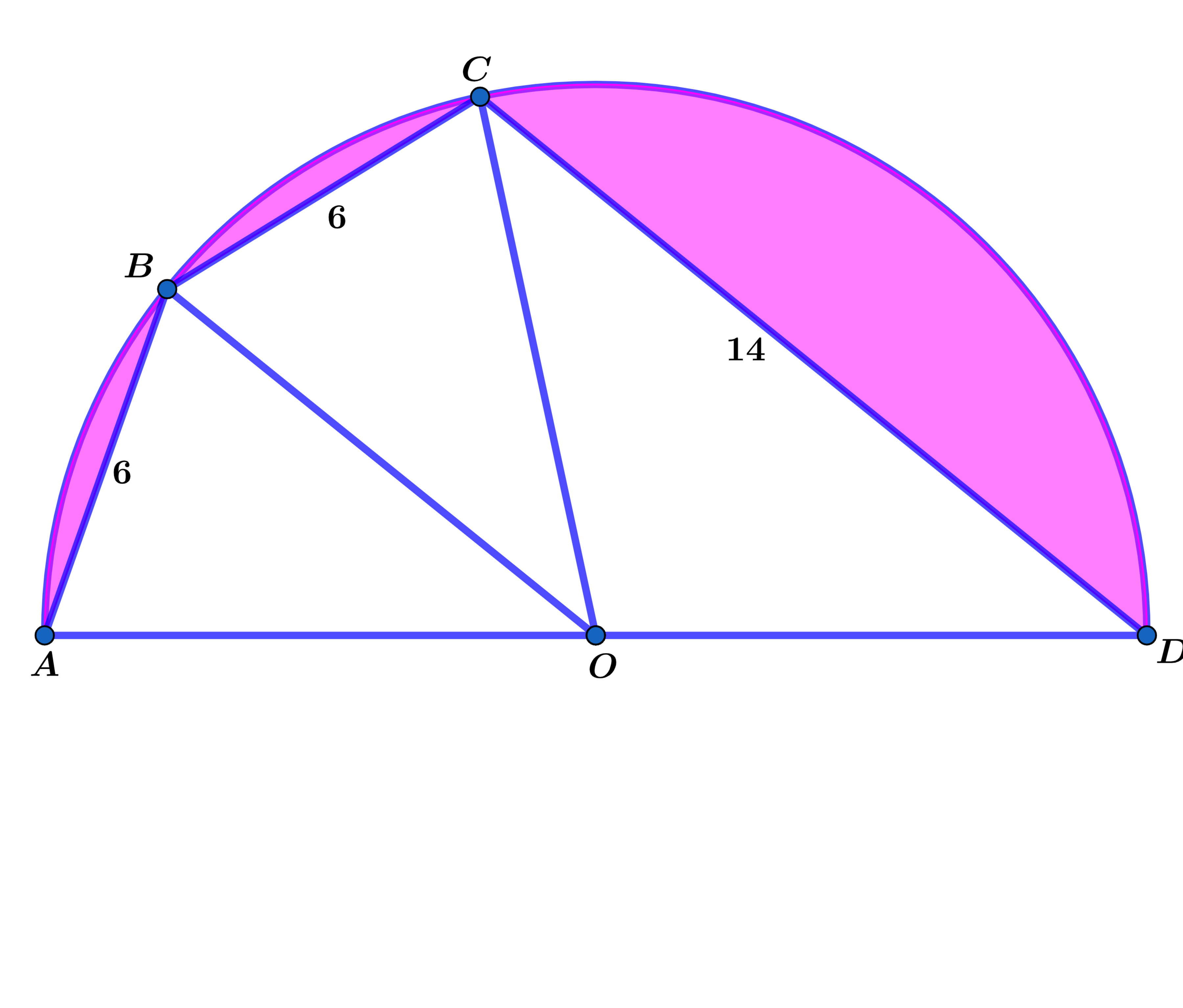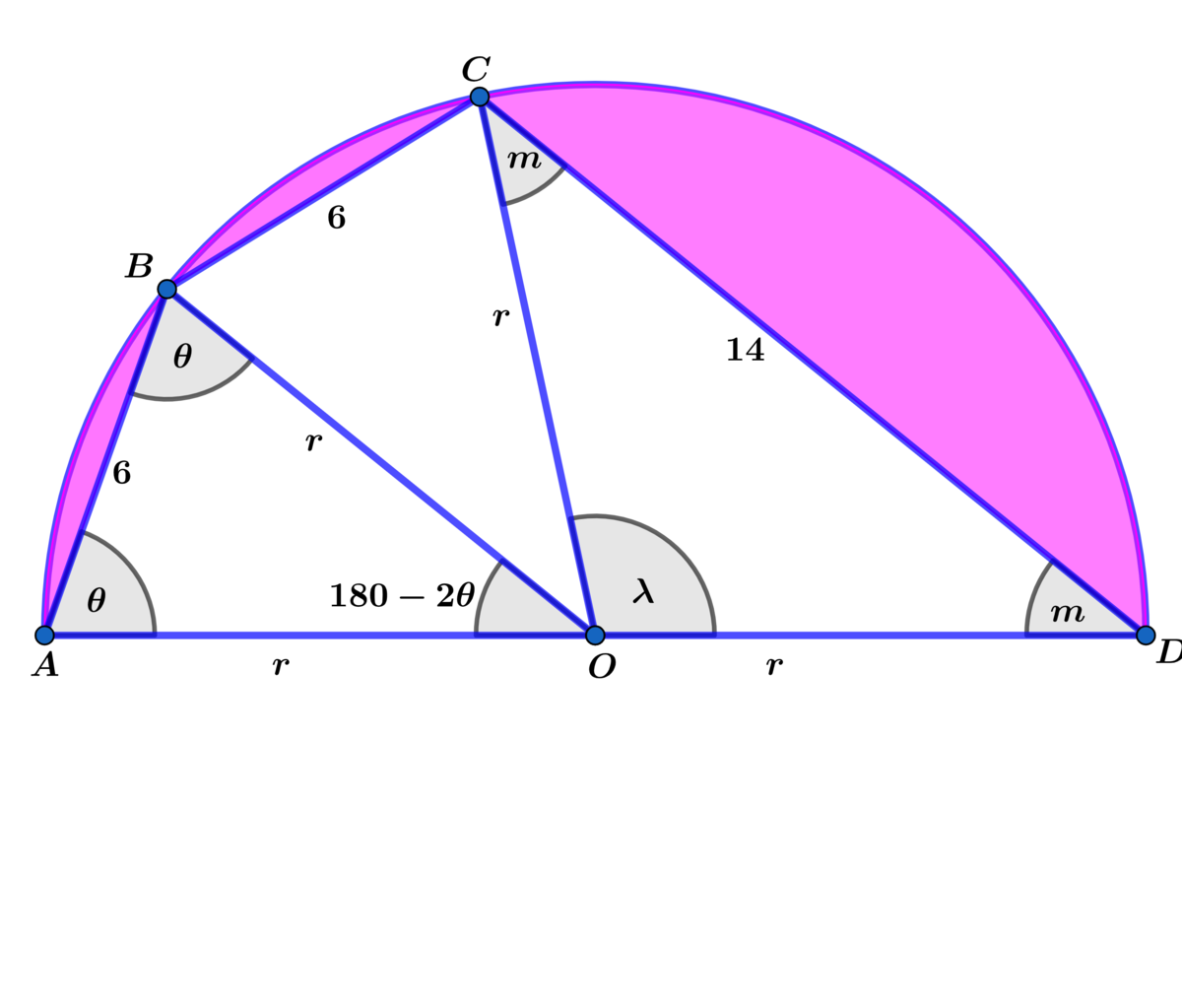Segments of a Circle

In the above semicircle, chords A B , B C and C D have lengths 6 , 6 and 1 4 respectively.
If the area A of the shaded regions above can be expressed as A = c a π − b c , where a , b and c are coprime positive integers, find a + b + c .
The answer is 147.
This section requires Javascript.
You are seeing this because something didn't load right. We suggest you, (a) try
refreshing the page, (b) enabling javascript if it is disabled on your browser and,
finally, (c)
loading the
non-javascript version of this page
. We're sorry about the hassle.
2 solutions

Using the above diagram 2 ( 1 8 0 − 2 θ ) + λ = 1 8 0 ⟹ λ = 4 θ − 1 8 0 ⟹
m = 1 8 0 − 2 θ .
For △ A O B using the law of cosines we have:
3 6 = 2 r 2 ( 1 − cos ( 1 8 0 − 2 θ ) ) ⟹ 1 8 = r 2 ( 1 + cos ( 2 θ ) ) ⟹ r 2 = 1 + cos ( 2 θ ) 1 8
and
for △ C O D using the law of cosines we have:
1 9 6 − 2 r 2 ( 1 + cos ( 4 θ ) ) ⟹ 4 9 = r 2 ( cos 2 ( 2 θ ) ) ⟹
4 9 + 4 9 cos ( 2 θ ) = 1 8 cos 2 ( 2 θ ) ⟹ 1 8 cos 2 ( θ ) − 4 9 cos ( 2 θ ) − 4 9 = 0 ⟹
cos ( 2 θ ) = 2 4 9 ± 7 7 and ∣ cos ( u ) ∣ ≤ 1 ⟹ cos ( 2 θ ) = − 9 7
⟹ r 2 = 1 − 9 7 1 8 = 8 1 ⟹ r = 9 .
Let h 1 be the height of △ A O B ⟹ h 1 = 8 1 − 9 = 7 2 = 6 2 ⟹
A 1 = 2 ∗ A △ A O B = 3 6 2
Let h 2 be the height of △ C O D ⟹ h 2 = 8 1 − 4 9 = 3 2 = 4 2 ⟹
A 2 = A △ C O D = 2 8 2
⟹ Area of quadrilateral A B C D is A A B C D = A 1 + A 2 = 6 4 2 ⟹
The desired area is A = 2 8 1 π − 6 4 2 = c a π − b c ⟹ a + b + c = 1 4 7 .
Let ∠ C O D = α and ∠ C O B = ∠ B O A = β . Then α + 2 β = 1 8 0 ∘ . Let the radius of the semicircle be r . By cosine rule we have 2 r 2 ( 1 − cos α ) = 1 4 2 and 2 r 2 ( 1 − cos β ) = 6 2 . Therefore,
1 − cos β 1 − cos α 9 − 9 cos α − 9 cos ( 1 8 0 ∘ − 2 β ) + 4 9 cos β − 4 0 9 cos ( 2 β ) + 4 9 cos β − 4 0 1 8 cos 2 β + 4 9 cos β − 4 9 ⟹ cos β cos α = 6 2 1 4 2 = 4 9 − 4 9 cos β = 0 = 0 = 0 = 9 7 = − cos 2 β = sin 2 β − cos 2 β = − 8 1 1 7 Putting α = 1 8 0 ∘ − 2 β Note that cos ( 1 8 0 ∘ − θ ) = − cos θ and cos ( 2 θ ) = 2 cos 2 θ − 1 ⟹ sin β = 9 4 2 ⟹ sin α = 8 1 5 6 2
From 2 r 2 ( 1 − cos β ) = 6 2 ⟹ r 2 = 8 1 . The area of the quadrilateral A A B C D = 2 1 r 2 sin α + r 2 sin β = 6 4 2 and the area of the shaded regions A = 2 1 π r 2 − A A B C D = 2 8 1 π − 6 4 2 . Therefore a + b + c = 8 1 + 2 + 6 4 = 1 4 7 .